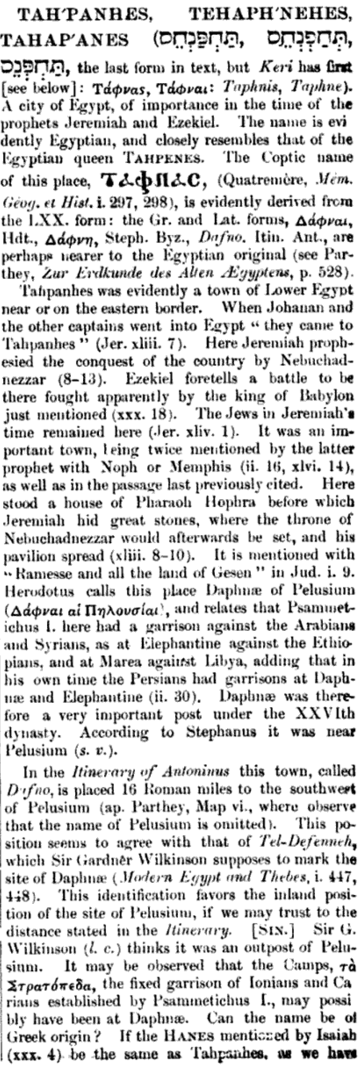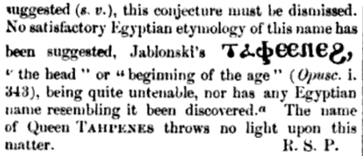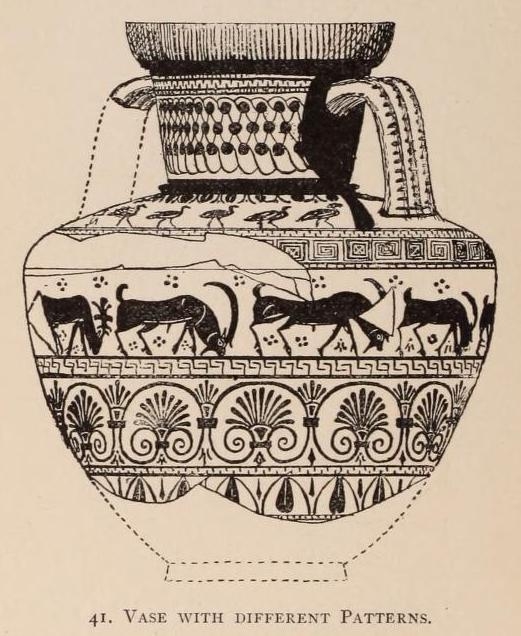|
Other Archaeological Sites / The Neolithic of the Levant (500 Page Book Online) Ancient Tahpanhes (Greek Daphnae) in Egypt In the reign of Psammetichus I there were watchposts at Elephantine facing Ethiopia, at Daphnae of Pelusium facing Arabia and Assyria, and at Marea facing Libya. And still in my time the Persians hold these posts as they were held in the days of Psammetichus; there are Persian guards at Elephantine and at Daphnae (Herodotus 2.30). DAPHNE: an ancient fortress near the Syrian frontier of Egypt on the Pelusian arm of the Nile. Here King Psammetichus established a garrison of foreign mercenaries, mostly Carians and Ionian Greeks (3). To the Ionians and Carians who had helped him, Psammetichus gave places to live in called The Camps, opposite each other on either side of the Nile; and besides this, he paid them all that he had promised (Herodotus 2.154).
The eastern Delta site Tell Defenneh (Daphne) plays a special role in the story of Greeks and Egyptians in this period. Located on the Pelusian branch of the Nile, the site was partially excavated in 1886 by Petrie. At present it is the location in Egypt with the most Greek painted pottery -- apart from Naukratis. Petrie thought it was a palace-fort with a Greek mercenary population because of its strategic position at the border of the eastern Delta and the high proportion of Greek pottery finds. Satellite images published by Leclere show that the site was merely a huge temple precinct or a temple-town (Leclere 2007: 14-17; SEE Publications in (7) 2008: 507-540). During recent excavations (2009-2010) by the Egyptian Antiquity Service traces of a huge precinct wall of a large temple area with remains of store rooms and temple buildings were found (6).
(1) The Histories --- Herodotus 2.30
(2) The Histories --- Herodotus 2.154
(3) Daphnae in the 1911 Encyclopædia Britannica
(4) Ten Years' Digging in Egypt: 1881-1891 by William Matthew Flinders Petrie (1886)
(5) Dr. William Smith's Dictionary of the Bible --- Volume 4 (Page 3169-70) 1888
(6) A Companion to Greek Art by Tyler Jo Smith and Dimitris Plantzos (2012)
(7) Egyptian – Greek relations at Daphnae (Nile Delta) at © 2017 Trustees of the British Museum
(8) An Egyptian temple at Tell Dafana? by François Leclère in the The Bulletin of the Egypt Exploration Society (2007)
(9) Tell Dafana Reconsidered:The Archaeology of an Egyptian Frontier Town by François Leclère and Jeffrey Spencer --- Trustees of the British Museum 2014
Tahpanhes in the International Standard Bible Encyclopedia (1939)
Tahpanhes --- WikiPedia
|




